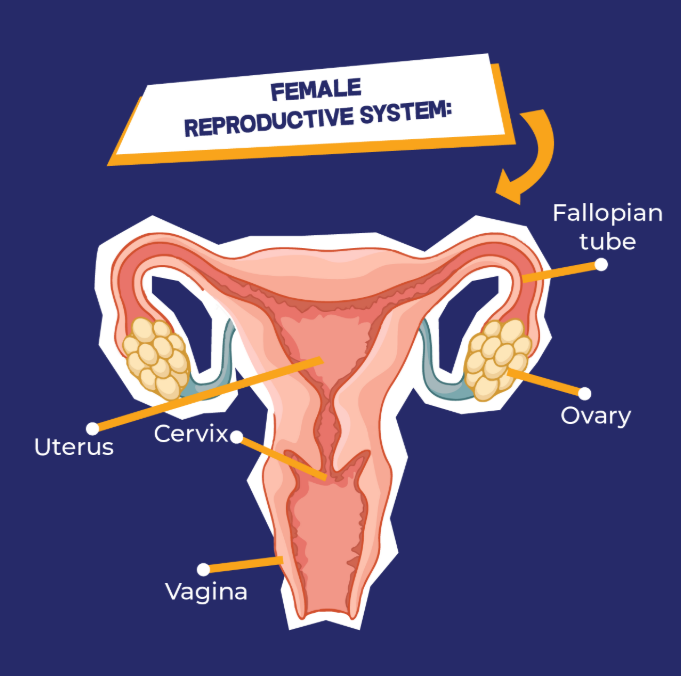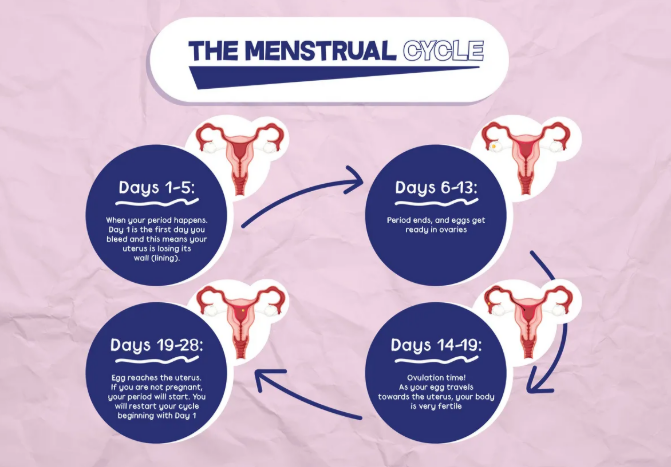

The female reproductive system is made up of organs which are on the inside and outside of the body. These organs each play a role in reproduction (having children).

The vulva is the fleshy part found on the outside of the body and is made up of the labia (which are folds of skin that look like lips), the clitoris* as well as the opening to the urethra as well as the vagina. Learn what your vulva looks like by taking a mirror and having a look! There is no shame in doing this!
The urethra is a tube that carries urine (pee) from the bladder to outside of the body.
The vagina is the opening between a female’s legs. The vagina is the passage that menstrual blood (period) comes out of and where a baby is pushed through. The vagina is also where a penis can be inserted. Other body parts such as the mouth (oral sex), fingers or both can also be inserted into the vagina for pleasure. Sex toys can also enter the vagina during sex. A thin layer of skin called a hymen can sometimes cover the opening of the vagina. Not all females are born with a hymen and some hymens tear even before a person has sex for the first time. Not having a hymen doesn’t mean you have had sex.
The cervix is a ring of muscle at the top of the vaginal passage, sort of like a ‘doorway’ into the uterus. The cervix has a small opening which means that a tampon can’t get lost inside the body. The cervix stretches when a baby is born so it can pass through.
Also called the womb. The uterus is where a baby grows during pregnancy and its strong muscles help push a baby out during labour. The lining of the uterus also sheds if you are not pregnant and forms part of what comes out as your period.
These are two tubes that connect the ovaries to the uterus. The ovum (egg) travels down the fallopian tube where it can be fertilized (by the sperm).
These organs produce eggs and are where the female hormones (chemical messengers) oestrogen and progesterone are made. If an egg is fertilised by a sperm, you can get pregnant.
Part of the clitoris is seen as a bump at the top of the vulva, but this organ is much bigger inside the body. It can be the size of a pea or as big as a thumb. This organ does not play a role in reproduction (having children) but it forms part of the female reproductive system. The clitoris exists just for pleasure. If you want to have an orgasm, the clitoris is the easiest way to get there.

Menstruation, or getting your period, is the number of days (usually 2–7 days) every month when blood comes out of your vagina. It can be scary at first! But this is a natural process that is normal.
Most females have thousands of eggs inside their ovaries (the part of the body that makes the eggs).
During puberty, these eggs in the ovaries start to ripen and are released one at a time, every month.
The ripened egg is ready to receive sperm so if sperm enters the egg through a process called fertilization, then a female can become pregnant. When you’re not pregnant, then the egg is shed from the body once a month. It is shed together with the extra lining of the uterus (womb). A typical menstrual cycle happens about every 28 days, but it can be longer or shorter depending on your body.
When you get your period, there are several options you can use to soak up the blood. You can use a sanitary pad/towel, a tampon, or a menstrual cup. We will tell you what you need to know about each one of them.
These are pads that you can’t use more than once. You put the pad inside your underwear to soak up the blood from your
period. Some pads have a side that sticks onto your underwear to keep the pad in place. Some even have sticky ‘wings’
to stop leaks. Remember to change your pad every 4–6 hours depending on how heavy your period flow is.
The pad can feel much bigger than it looks. They also come in different sizes and shapes.
Pick the one that is most comfortable for you. You can use any clean pieces of material that will soak up the blood.
Fold the material well into a rectangle and put it inside your underwear. Change and wash the cloth with soap and cold
water between every use and iron it or hang it in the sun to kill any germs.
Tip: If you’re going to school or using other public toilets, take a packet to keep the material in so you can
wash it when you get home.
A tampon is a tube of special cotton wool. You put the tampon inside your vagina to soak up the blood before it comes
out. A little string hangs from the tampon and out of your vagina, so that you can pull the tampon out when you’re
done with it. Do not use ordinary cotton wool. Only use tampons that are made especially for periods.
Tampons come in different sizes depending on how much blood they hold. They call this absorbency. Try to use the lowest
absorbency tampon you can until you know which ones work best for you. A tampon may feel strange to use at first.
They’re easy to use once you get used to them. If you can feel the tampon, it’s not in properly. Only use one at a time
and change it every 4–6 hours, even if there isn’t much blood in them.
The vagina has a tube at the top called a cervix. And the opening in the cervix is too small for the tampon to go
through. If you can’t find the tampon string, take a moment, breathe, and calmly insert your finger into your vagina
and look for it. If you’re very worried, talk to a trusted adult about it.
You can flush your used tampons if you are using a flush toilet. For pit toilets, it’s better to throw them out in the
rubbish. Never flush pads. You can wrap them in paper or the plastic they come in and put them in the bin.
A menstrual cup is a small, rubbery cup that you place in your vagina like you would with a tampon. You can wash and reuse it, and it lasts many years. It’s safe and hygienic. Some people say it takes time to get used to it, because it collects the blood, and you have to dump the blood into the toilet. You then need to wash it out before you reinsert it.
You may sometimes find light spots of blood on your underwear when you are not on your period. This is called ‘spotting’.
There are several reasons why you could be spotting. These are the most common ones: